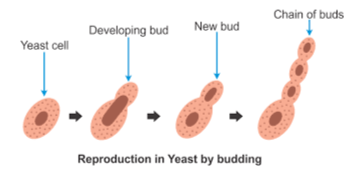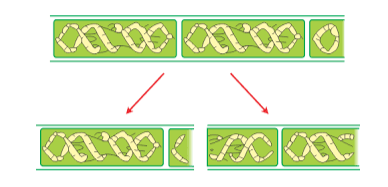REPRODUCTION IN PLANTS for Class 7 SCIENCE
INTRODUCTION
Hum jante hai ki reproduction ek process hai jisme parents se same kind ke new individuals produce hote hai. Sabhi organisms earth par apni species ki existence ke liye reproduction perform karte hai aur reproduction ke bhi different modes hote hai. Iss chapter mein hum plants mein reproduction ke baare mein padhenge, iske different modes ke baare mein padhenge, isme fruits aur seeds kaise form hote hai iss baare mein padhenge. Yaha hum seed dispersal ke baare mein bhi padhenge.
Modes Of Reproduction
Plants ke do modes of reproduction hote hai- Sexual reproduction and asexual reproduction.
Asexual reproduction
Ek aisa process jisme same kind ke new individuals ke formation mein single parent involve hota hai usko asexual reproduction kehte hai. Iss type ke reproduction mein plants without seeds new plants ko rise karte hai. Asexual reproduction ke bhi different types hote hai.Vegetative reproduction- Roots, stems, leaves aur buds plants ke vegetative parts hote hai. Yeh ek aisa type of reproduction hai jisme vegetative parts se new plants produce hote hai. Iss method se plants grow karne mein less time lete hai aur inn par jaldi hi fruits aur flowers aa jate hai. Isme jo plants produce hote hai woh apne parent plant ki exact copies hote hai.
Eg- Hum champa ya rose ke flower ki node cut karke usko soil mein bury karke bhi new plant grow kar sakte hai. Iss method ko hum cutting method kehte hai. Lekin iss method mein hamein ek baat dhyan rakhni chahiye ki hum jo stem bury karte hai usme buds hone chahiye kyonki yeh buds hi grow karke new plant ko rise karte hai. Issi tarah hum bahut saare aur plants jaise cactus, money plant, grapes, sugarcane, etc. ko bhi vegetative reproduction ki help se grow kar sakte hai.
Budding- Hum sabne dekha hai ki flower buds se flowers develop hote hai issi tarah plants ki axil mein bhi buds present hote hai jo shoots mein develop hote hai, inn buds ko hum vegetative buds kehte hai. Eg- Yeast ko hum budding se grow kar sakte hai. Hum kuchh yeast powder lenge aur usko water ke sath ek container mein rakhenge, usme ek spoonful sugar add karenge aur shake karke dissolve karenge. Usko kuchh der ke liye ek warm room mein rakhenge aur one hour ke baad iss liquid ki ek drop ko glass slide par microscope ke under observe karenge. Hum dekhenge ki isme new yeast cells form ho rahe hai. Niche figure mein hum dekh sakte hai ki inki growth kaise hoti hai.

Hum dekhte hai ki yeast mein kuchh small bulb like projection banne lagti hai. Iss bulb-like projection ko hum bud kehte hai. Bud grow karta hai aur parent cell se detach ho jata hai aur ek new yeast cell banata hai. Iss tarah se budding mein new cells ki formation hoti hai lekin sometimes yeh bud detach nahi hote aur inke upar aur bud form hote chale jate hai aur buds ki ek chain form karte hai. Iss tarah se ek short period of time mein bahut saare new cells produce ho jate hai.
Fragmentation- Iss method mein parent cell ki body small pieces mein break ho jati hai jisko hum fragments kehte hai aur har ek fragment new plant mein grow karti hai. Body ki fragmentation mature plants mein hi hoti hai. Jab water mein sabhi nutrients present hote hai toh available algae fragmentation ke through grow aur multiply karne lagti hai.

Spore formation- Spores small, spherical bodies hoti hai, inn par ek thick protective wall hoti hai jo inko unfavourable conditions se protect karti hai. Jab inn spores ko favourable conditions milti hai toh inki walls burst ho jati hai aur yeh germinate karke new plants ki tarah develop karna start kar dete hai. Kuchh fungus like bread moulds etc. issi method se reproduce karte hai.

Spores bahut light light hote hai toh woh kafi jyada distance cover kar sakte hai. Moss aur ferns bhi issi method se reproduce karte hai.
Sexual reproduction
Yeh ek aisa process hai jisme do parents involve hote hai. Iss type ke reproduction mein seeds se new plants grow karte hai. Flowers plant ka reproductive part hote hai. Stamens inka male reproductive part hote hai, pistil inka female reproductive part hote hai.

Flowers bhi do type ke hote hai- unisexual flowers aur bisexual flowers.
Female reproductive organ pistil mein stigma, style aur ovary present hote hai. Ovary mein ek ya ek se jyada ovules present hote hai jo female gamete ya egg produce karte hai.
Sexual reproduction mein yeh male aur female dono gamete fuse karke zygote banate hai.
Lekin kya aapne kabhi socha hai ki yeh male gamete, female gamete tak kaise pahuchta hai? Iske baare mein hum next topic mein padhenge.
Pollination
Pollen grains ka anther se stigma par transfer hone ke process ko pollination kehte hai.
Pollen grains par ek tough, protective layer hoti hai jo unko dry hone se bachati hai. Yeh bahut light hote hai isliye wind, water ya insects ke through ek jagah se doosri jagah transfer ho jate hai. Ab yeh pollen apne hi plant ke stigma par bhi ja sakte hai aur doosre plant ke stigma par bhi ja sakte hai. Iske according hi hum pollination ko bhi do types mein divide kar sakte hai- self pollination aur cross pollination.
Self pollination: Agar kisi flower ka pollen apne hi plant ke stigma par land karta hai toh usko self pollination kehte hai.
Cross pollination: Agar kisi flower ka pollen same kind ke kisi doosre plant ke stigma par land karte hai toh usko cross pollination kehte hai.

Fertilisation
Male gamete aur female gamete ke fusion ke process ko fertilisation kehte hai.Jab fertilisation hota hai tab zygote banta hai aur yeh zygote develop ho kar embryo banta hai.

Ab dekhte hai ki fertilisation ke baad kya hota hai?
Fruits And Seed Formation
Fertilisation ke baad ovary fruit ki form mein grow karna start kar deti hai aur flower ke other parts fall off ho jate hai.Hum jo fruit khate hai woh ek flower ki ripened ovary hoti hai jo seed ko protect karti hai. Kuchh fruits fleshy hote hai, kuchh fruits hard hote hai.
Seed Dispersal
Parent plant se different places par seeds ke transportation ke process ko seed dispersal kehte hai. Seed dispersal ki wajah se different places par same type ke plants grow karte hai. Seed dispersal hamare liye helpful hota hai kyonki yeh same place ke same plants ke beech mein food, sunlight, water aur minerals ke liye competition ko finish kar deta hai. Seed dispersal ki wajah se unko ek different habitat mein develop karne ka chance bhi milta hai.
Seeds ka dispersion different factors ki wajah se hota hai.




POINT 1
Reproduction: “Reproduction is the process of producing offsprings that are biologically or genetically similar to the parent organism.
Asexual Reproduction: Asexual reproduction is a mode of reproduction in which a new offspring is produced by a single parent.
Sexual Reproduction: Sexual reproduction is a type of reproduction that involves the production of an offspring by the fusion of male and female gametes.
Vegetative propagation: Vegetative reproduction is any form of asexual reproduction occurring in plants in which a new plant grows from a fragment or cutting of the parent plant.
Budding: Budding is a type of asexual reproduction in which a new organism develops from an outgrowth or bud due to cell division at one particular site.
Spore formation: Spore formation is a form of reproduction in which the reproductive bodies called the spores are present in a sac called the sporangia.
Fragmentation: Fragmentation refers to the state or the process of breaking into smaller parts, called fragments.
Pollination: Pollination is the act of transferring pollen grains from the male anther of a flower to the female stigma.
Self-pollination: The meaning of self-pollination is the transfer of pollen from the anther of a flower to the stigma of the same flower.
Cross pollination: The meaning of cross-pollination is the transfer of pollen from one flower to the stigma of another.
Fertilisation: The process of combining the male gamete, or sperm, with the female gamete, or ovum.
Seed dispersal: Seed dispersal is the mechanism by which plant seeds are transported to new sites for germination and the establishment of new individuals.
SUMMARY
1. All organisms multiply or reproduce their own kind.
2. In plants there are two modes of reproduction, asexual and sexual.
3. There are several methods of asexual reproduction such as fragmentation, budding, spore formation and vegetative propagation.
4. Sexual reproduction involves the fusion of male and female gametes.
5. In vegetative propagation new plants are produced from different vegetative parts such as leaves, stems and roots.
6. Flower is the reproductive part of a plant.
7. A flower may be unisexual with either the male or the female reproductive parts.
8. A bisexual flower has both the male and the female reproductive parts.
9. The male gametes are found inside the pollen grains and female gametes are found in the ovule.
10. Pollination is the process of transfer of pollen grains from the anther of one flower to the stigma of the same or another flower.
11. Pollination is of two types, self-pollination and cross-pollination. In self-pollination, pollen grains are transferred from the anther to the stigma of the same flower. In cross-pollination, pollen grains are transferred from the anther of one flower to the stigma of another flower of the same kind.
12. Pollination takes place in plants with the help of wind, water and insects.
13. The fusion of male and female gametes is called fertilisation.
14. Fertilised egg is called zygote. Zygote develops into an embryo.
15. Fruit is the mature ovary whereas ovule develops into a seed, which contains the developing embryo.
16. Seed dispersal is aided by wind, water and animals.
17. Seed dispersal helps the plants to (i) prevent overcrowding, (ii) avoid competition for sunlight, water and minerals and (iii) invade new habitats